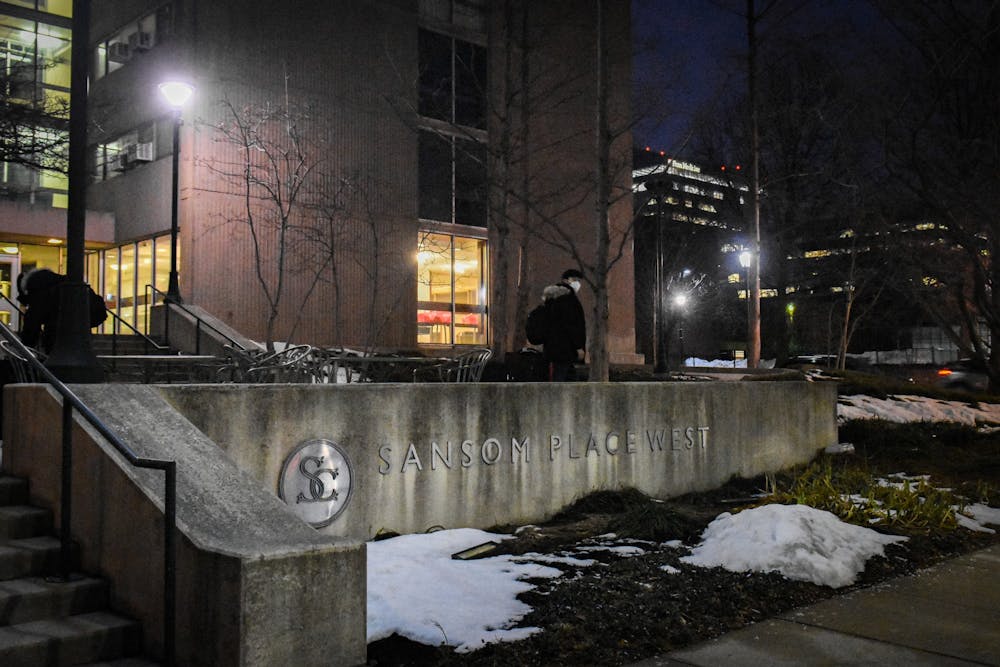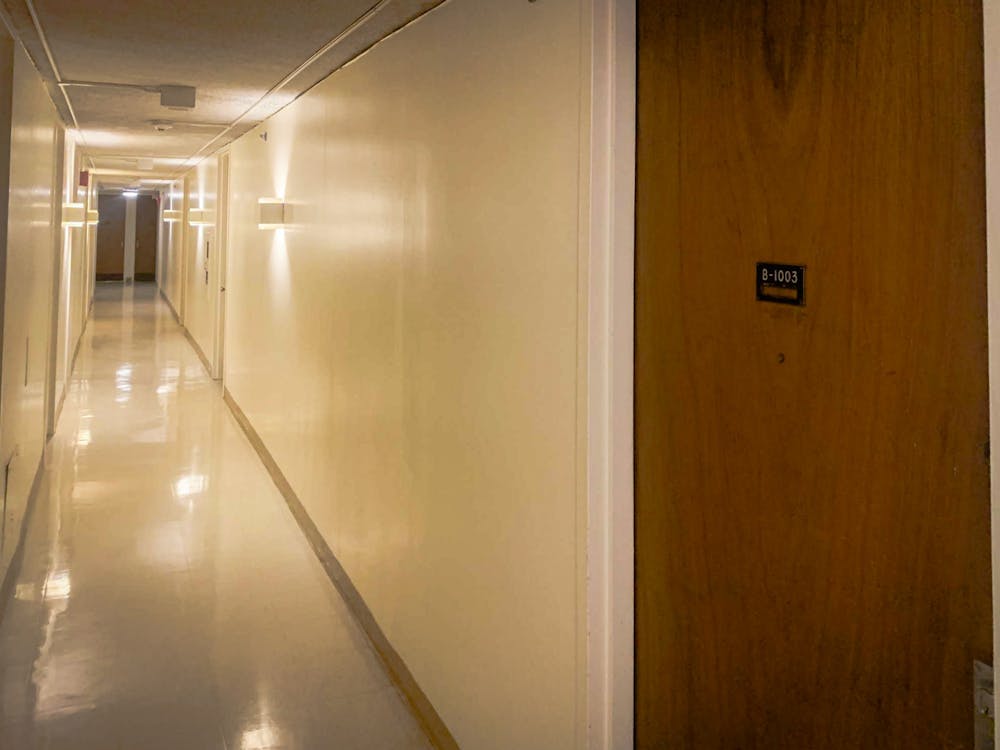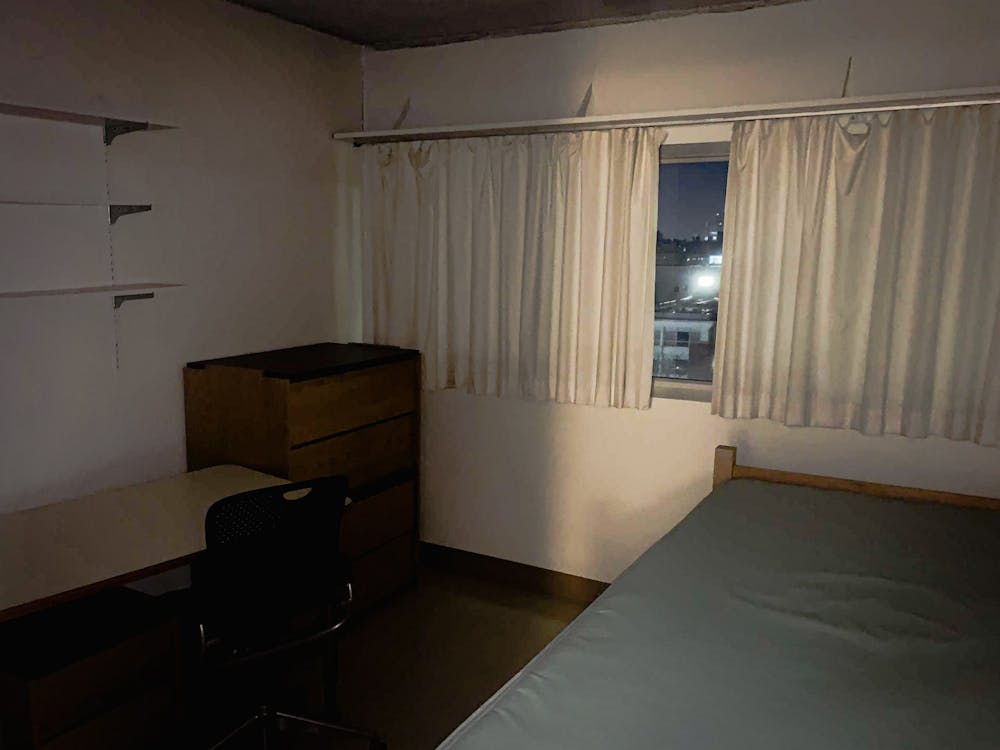
As COVID-19 cases continue to spike on campus and isolation capacity decreases, some students isolated in Sansom Place West after testing positive are reporting inadequate and confusing meal policies and violations of safety guidelines.
If a student living in campus housing tests positive for COVID-19, the University moves them to Sansom Place West for isolation. Several of these students, some currently in isolation and some who were isolated last month, told The Daily Pennsylvanian that communication from Penn regarding how to receive meals, what supplies the rooms would have, and what to do if they became symptomatic, was at times unclear.
Penn’s isolation capacity is at 56.9% for the week of Jan. 31 through Feb. 6. Currently, 388 students are in isolation. During the week of Jan. 10 through Jan. 16, 107 students were in isolation.
The decreasing capacity comes as cases are rising on campus. The undergraduate positivity rate for the week of Jan. 31 through Feb. 6 — 4.47% — doubled from the week prior. Penn warned last week that it may invoke a quarantine policy in response to the rise in cases.
College first year Morgan Zinn said that the University wrote in an email to students in isolation that some have been violating the Student Campus Compact COVID-19 guidelines.
On Tuesday, Chief Wellness Officer Benoit Dubé sent an email to students isolating in Sansom Place West urging them to wear masks outside their rooms.

A hallway inside of Sansom Place West. Students are encouraged to wear face masks when exiting their rooms. (Photo from Yash Dhir)
“It has come to our attention that students in Sansom Place West are not wearing a face covering when they are outside of their room, which places members of our community at risk,” Dubé wrote. “Not wearing a face covering is a direct violation of the Student Campus Compact. Students must wear a face covering anytime they leave their room.”
College first year Amelia Hemphill said she has also heard from her friend currently isolating in Sansom Place West that students are leaving their rooms and gathering together in large groups.
Students, including College sophomore Noah Beratan, also reported unclear communication from Penn about how they would get food in isolation and what amenities the room would have. Beratan called on Penn to provide food for students in isolation, or at least provide clear information that students will not have food provided.
Beratan was unknowingly exposed to COVID-19 at home a few days before coming to campus on Jan. 10. When Beratan, who was previously vaccinated in the Johnson & Johnson vaccine study, found out his family members had contracted the virus shortly after he moved in to Harnwell College House, he reported the exposure to Penn and got a COVID-19 test at Irvine Auditorium for symptomatic and exposed students. His test soon came back positive.
Contact tracers initially told Beratan he would have to stay in Sansom Place West for seven days, but he was later told that he would have to stay for 10 days because he was asymptomatic. Penn's isolation policies require isolation for at least 10 days for both symptomatic and asymptomatic students.
The information Beratan received in an email from the University before isolating gave him a three-hour window to move in and told him that he would have supplies such as linens and cleaning products provided. The email Beratan received also stated that he would have access to meals, but did not offer further details.
Beratan, who is not on a meal plan, found out when he got to his isolation room that this meant he could order meals from the dining hall at a price of $17 per meal, or have food and groceries delivered either by a delivery service or a friend. Beratan said there were some microwavable snacks and meals in the room when he arrived, like instant ramen.
“[It was] enough to get me through probably two or three days, but it wasn't filling or nutritious meals,” Beratan said.
Beratan said that he did not expect to have to pay out of pocket for delivery during his 10-day isolation. He added that he asked two people, the contact tracer he spoke to and a guard in the building, prior to moving in if his room had a stove, but neither person knew, so he did not bring food with him that he could have cooked. His room ended up having a stove.
“They're not obligated to feed me if I'm not on a meal plan, but I was under the impression that if this happened they would be providing me with meals,” Beratan said. “That's what I thought going in.”
Beratan said his family was able to order groceries to be delivered for him, but emphasized that not every student might be able to afford delivery for 10 days.
College first year James Doh, who also isolated in Sansom Place West, is on a meal plan, and said he appreciated that Penn let him order meals both from the dining hall and from other restaurants through UberEats.
Hemphill was also on a dining plan during her time in Sansom Place West on Jan. 12, but said that even with the ability to order meals online, Penn’s communication about how to order meals was unclear.
Hemphill said that the card in her room, as stated online, provided information on how to order food from the dining hall told her that she could order food until 11:59 p.m. for the next day, but when she tried to order food for the next day after 6 p.m., she was unable to.
She instead ate oatmeal from the room out of a cup Penn provided because there were no bowls.
A dorm inside of Sansom Place West, where students with positive Covid-19 cases are required to isolate for 10 days. (Photo from Yash Dhir)
Zinn, who entered isolation on Feb. 4, also encountered difficulties ordering food to his isolation room. Although he is on a dining plan, the SIQ meals option to have his food delivered still displayed a cost of $14 instead of one meal swipe. Zinn said he was confused because he thought he would be able to use his meal swipes instead of paying in dining dollars or cash, and felt that $14 for two slices of pizza was excessive.
Doh was never symptomatic during his isolation that began on Jan. 13. During his 10-day stay in Sansom Place West, Doh said he received a call from Student Health Service checking in on him and his symptoms on the first day, but did not hear from SHS for the rest of his isolation.
Hemphill, who was symptomatic, said that nurses called to check in with her three times over her isolation period, and once was told to go to SHS in person because of shortness of breath.
She added that her experience was likely different from those of people isolating now, as the number of students in isolation has increased. When Hemphill moved in on Jan. 12, she was on the first floor. Now, with rising cases on campus, Hemphill said a friend of hers is living on the ninth floor.
Beratan said that because he was one of the first students to enter isolation at Sansom Place West, he hopes that the University and contact tracers will be able to provide better communication to students for what they can expect about food and their rooms as the semester continues.
“I'm assuming as time goes by, they'll learn from it,” Beratan said.
The Daily Pennsylvanian is an independent, student-run newspaper. Please consider making a donation to support the coverage that shapes the University. Your generosity ensures a future of strong journalism at Penn.
Donate



